|
Cash Bids
Market Data
News
Ag Commentary
Weather
Resources
|
Chevron Stock's 4.6% Dividend Yield and 1.67% One Month Short Put Yield Make CVX a Buy
Chevron Corp (CVX) stock boasts a handsome 4.6% yield, significantly higher than its historical average. As this article will show, CVX stock could be worth between 11% to 20% more. Moreover, selling short put options expiring in just over one month can provide investors a 1.67% monthly yield at out-of-the-money strike prices. With CVX's closing price on July 3 of $148.37, CVX is still well off its recent highs in mid-April. But it could still have room to rise further. This article will show how to play this. 
Dividend Yield Price TargetI discussed CVX stock's average yield in my last article on June 16 ("Chevron Stock Looks Cheap Based on Its Average Yield - Shorting Puts Works"). For example, with its annual dividend per share (DPS) of $6.84 (i.e., $1.71 quarterly x 4), the yield is 4.61%. But this is higher than its 5-year average. As a result, CVX is worth between $165 and $181. Let's see why. Over the next 12 months (NTM), an investor can likely expect Chevron will raise its quarterly dividend rate. Let's estimate that the next rate will be $1.78 per share, +4% YoY. That means the NTM DPS rate will be $6.98 per share, and so today's NTM yield is actually over 4.7%: $6.98 / $148.37 = 0.04704 = 4.704% (NTM Yield) That is well over its 5-year average yield: Yahoo! Finance.……4.36% Seeking Alpha …….4.21% Morningstar ……….4.17% Average 5-yr Yield 4.25% As a result, we can project CVX stock's value should it revert to its historical mean, using the NTM dividend per share (DPS): $6.98 NTM DPS / 0.0425 = $164.24 target price That is almost 11% higher than the July 3 closing price: $164.24/$148.37 = 1.1069 -1 = +10.7% upside This also coincides with analysts' target prices. Analysts See CVX UndervaluedAnalysts surveyed by Yahoo! Finance (25) have an average price target of $163.23 per share, or +10% higher than today. Similarly, Barchart's mean price target is $161.73, and StockAnalysis.com says the average from 15 analysts is $164.79 (close to my price target). However, AnaChart.com, which covers recent analyst write-ups, shows that 21 analysts have an average of $181.20 per share. That is +22% higher than today. The bottom line is that the median of these surveys is $164.01, very close to my dividend-yield-based target of $164.24. As a result, there seems to be +10-11% potential upside in CVX stock, and potentially up to 22% more. But there is no guarantee this will occur over the next 12 months. Therefore, one way to play this is to set a lower potential buy-in price. Investors can do this by selling short out-of-the-money (OTM) put options in a near-term expiry period (usually one month is ideal). The upside here is that investors can make a good one-month yield with this play. Short-Put Yields are AttractiveMy last article on June 16 pointed out that the $140 strike price put option expiring July 18 had a midpoint premium of $2.07, a one-month yield of 1.48% ($2.07/$140.00). This strike price was 3.3% below the trading price (i.e., out-of-the-money or OTM). Today, the price is just 39 cents, so the short-put investor has made most of the yield. They can roll this over (i.e., “Buy to Open”) and do a new trade further out. For example, look at the August 8 expiration period, which is just over one month away. The $144.00 put option, 3% below the trading price, has a midpoint premium of $2.41. That gives the short put investor a one-month yield of 1.67% (i.e., $2.41/$144.00). 
Note that this trade has a low probability of being assigned, less than one-third chance, since the delta ratio is -32.7%. In addition, the annualized potential return is attractive at 16.7% (i.e., 365/36 days to expiry). Moreover, even after rolling the prior trade over, $2.41-$0.39 = $2.02/$144.00 = 0.014 = 1.40%. In other words, the investor can make the same yield as before. Expected ReturnThe beauty of this type of trade is that the investor does not have to wait for the full expiration period to make good money. For example, the net income since June 16 is: $2.07 - $0.39 +$2.41 = $4.09 or $409 per put contract (with 100 shares per put contract) But the average investment would have been $14,200 (i.e., $140 strike price in the first trade and $144 in the second). Therefore, the net yield has been 2.88%: $409/$14,200 = 0.0288 = 2.88% This is over 53 days between June 16 and August 8 (and potentially shorter if the investor covers before then). Let's assume that most of the yield is made over the next 21 days. The investment period would be 40 days. So the annualized expected return (ER) is as follows: 365/40 = 11 periods x 2.88% = 31.68% That is a very high expected return, assuming that the investor can repeat this play every 40 days. The point is that these out-of-the-money puts are a very attractive way to play CVX stock. Moreover, the investor's breakeven point, should CVX stock fall 3% to the $144.00 strike price, makes this a good investment: $144.00-$2.41 = $141.59 $164.24 / $141.59 = 1.16 -1 = +16% The bottom line is that by shorting puts expiring in one month, the short-put CVX investor can make a potential +16% upside. Even if CVX doesn't fall, the short-put yield is 1.67% for slightly over one month. That works out to 16.7% annualized, and potentially up to almost 32% if these trades are duplicated every 40 days. On the date of publication, Mark R. Hake, CFA did not have (either directly or indirectly) positions in any of the securities mentioned in this article. All information and data in this article is solely for informational purposes. For more information please view the Barchart Disclosure Policy here. |
|
|